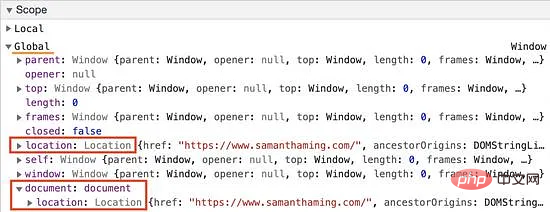
如果你想獲取站點的URL信息,那么window.location對象什么很適合你!使用其屬性獲取有關當前頁面地址的信息,或使用其方法進行某些頁面重定向或刷新
window.location.origin → '"https://segmentfault.com' .protocol → 'https:' .host → 'segmentfault.com' .hostname → 'segmentfault.com' .port → '' .pathname → '/search' .search → '?q=前端小智' .hash → '#2' .href → 'https://segmentfault.com/search?q=前端小智#2'
window.location.assign('url') .replace('url') .reload() .toString()
window.location 屬性
| window.location | 返回值 |
|---|---|
| .origin | 站點主地址(協議 + 主機名 + 端口) |
| .protocol | 協議架構 (http: 或者 htts:) |
| .host | 域名 + 端口 |
| .port | 端口 |
| .pathname | 最前頁的 '/' 后面跟的路徑 |
| .search | ? 后跟的查詢字符串 |
| .hash | 從 # 號開始的部分 |
| .href | 完整網址 |
host 和 hostname 的區別
在上面的示例中,你可能注意到host和hostname返回相同的值。那么為什么要這些屬性。好吧,這與端口號有關,讓我們來看看。
沒有端口的 URL
https://segmentfault.com/search
window.location.host; // 'segmentfault.com' window.location.hostname; // 'segmentfault.com' window.location.port; // ''
帶端口的 URL
https://segmentfault.com/search"8080
window.location.host; // 'segmentfault.com:8080' window.location.hostname; // 'segmentfault.com' window.location.port; // '8080'
因此,host將包括端口號,而hostname將僅返回主機名。
如何更改 URL 屬性
我們不僅可以調用location` 屬性來檢索URL信息,還可以使用它來設置新屬性并更改URL。
// 開始 'https://segmentfault.com/' window.location.pathname = '/tidbits'; // 設置 pathname // 結果 'https://segmentfault.com/tidbits'
下面是你可以更改的屬性的完整列表
// 事例 window.location.protocol = 'https' .host = 'localhost:8080' .hostname = 'localhost' .port = '8080' .pathname = 'path' .search = 'query string' // (這里不用寫 `?`) .hash = 'hash' // (這里不用寫 `#`) .href = 'url'
唯一不能設置的屬性是window.location.origin,此屬性是只讀的。
Location 對象
window.location返回一個Location對象。它為我們提供有關頁面當前地址的信息。但是我們還可以通過幾種方式訪問Location對象。
window.location → Location window.document.location → Location document.location → Location location → Location
我們這樣做的原因是這些是我們瀏覽器中的全局變量。

window.location vs location
上面四個屬性都指向同一個Location對象。我個人更喜歡window.location并且實際上會避免使用location。主要是因為location看起來像一個普通變量,并且我們有時可能會不小心將其命名為變量,這將覆蓋全局變量。舉個例子:
// https://www.samanthaming.com location.protocol; // 'https' function localFile() { const location = '/sam'; return location.protocol; // undefined // b/c local "location" has override the global variable }
我想大多數開發人員都知道window是一個全局變量。這樣就不太可能引起混淆。老實說,直到我寫了這篇文章,我才知道location 是一個全局變量。建議大家多使用 window.location 來代替其它寫法。
window.location 方法
| 方法 | 作用 |
|---|---|
| .assign() | 加載一個新的文檔 |
| .replace() | 用新的文檔替換當前文檔 |
| .reload() | 重新加載當前頁面 |
| .reload() | 返回的URL |
window.location.toString
根據 MDN :
此方法返回 URL 的 USVString,它是 Location.href 的只讀版本。
換句話說,我們可以這樣得到 href 的值:
// https://www.samanthaming.com window.location.href; // https://www.samanthaming.com window.location.toString(); // https://www.samanthaming.com
assign vs replace
這兩種方法都是重定向或導航到另一個URL。區別在于assign 是將當前頁面保存在歷史記錄中,因此用戶可以使用“后退”按鈕導航到該頁面。而使用replace方法時,不會保存它。讓我們來看一個例子。
Assign
1. 打開一個新的空白頁 2. 輸入 www.samanthaming.com (當前頁) 3. 使用 `window.location.assign('https://www.w3schools.com')` 載入新頁面 4. 按 "返回上一頁" 5. 返回到了 ???? www.samanthaming.com
Replace
1. 打開一個新的空白頁 2. 輸入 www.samanthaming.com (當前頁) 3. 使用 `window.location.assign('https://www.w3schools.com')` 載入新頁面 4. 按 "返回上一頁" 5. 返回到一個空白頁
如何讓頁面重定向
如何重定向到另一個頁面,有3種方法。
window.location.href = 'https://www.samanthaming.com'; window.location.assign('https://www.samanthaming.com'); window.location.replace('https://www.samanthaming.com');
replace vs assign vs href
這三個都可以重定向,區別在于瀏覽器的歷史記錄。href和assign 會把當前頁面保存在歷史記錄中,而replace則不會。因此,如果你想創建一種導航無法回到原始頁面的體驗,請使用replace????
現在的問題是href與assign。我更喜歡assign,因為它是一種方法,因此感覺好像我正在執行一些操作。還有一個額外的好處是它更易于測試。我已經編寫了許多Jest測試,因此通過使用一種方法,它使其更易于模擬。
window.location.assign = jest.fn(); myUrlUpdateFunction(); expect(window.location.assign).toBeCalledWith('http://my.url');
最終希望備忘單,希望能對你有所幫助,在需要的時候,能快速給你帶來答案。謝謝大家的觀看。
英文原文地址:https://morioh.com/p/b444d291bdfb
作者:Samantha Ming
譯者:前端小智
 站長資訊網
站長資訊網